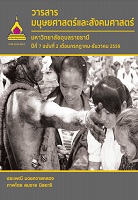ประวัติชาวจีนเมืองอุบลราชธานี ระหว่างปี พ.ศ. 2411-2488
Main Article Content
บทคัดย่อ
ประวัติศาสตร์ชาวจีนเมืองอุบลราชธานี ระหว่าง พ.ศ.2411-2488 เป็นการศึกษา โดยใช้มุมมองทางประวัติศาสตร์ในการศึกษาวิถีชีวิตกลุ่มชาติพันธุ์จีนเมืองอุบลราชธานี ครอบคลุมประเด็นด้านเศรษฐกิจ การเมือง และสังคม งานวิจัยนี้ได้ค้นพบว่า กลุ่มชาติพันธุ์ จีนที่อาศัยในเมืองอุบลราชธานีกลุ่มหลัก คือกลุ่มชาติพันธุ์จีนแต้จิ๋ว แซ่แต้ และแซ่ตั้ง ซึ่งมีบทบาทด้านเศรษฐกิจ การเมือง และสังคม 3 ช่วงเวลา ช่วงที่หนึ่ง ปี พ.ศ.2411-2447 คน จีนมีบทบาทที่เด่นด้านเศรษฐกิจ ประกอบอาชีพ 6 ประเภท คือ พ่อค้ารายย่อย พ่อค้าคนกลาง พ่อค้าระหว่างภูมิภาค ข้าราชการจากส่วนกลาง เจ้าภาษีนายอากร และแรงงานรับจ้าง คนจีนไม่มีบทบาททางการเมืองในช่วงเวลาดังกล่าว เนื่องจากคำมั่นสัญญาเรื่องการวางตัวเป็นกลางทางการเมือง ด้านสังคมนั้นนิยมแต่งงานกับสตรีพื้นเมืองมีฐานะเป็นเขยสู่เมืองอุบลราชธานี ศาลพุทธก๋งเป็นศูนย์รวมจิตใจ
ช่วงที่สอง ปีพ.ศ.2447-2472 สมัยการสะสมทุนระยะแรกของชาวจีนทำหน้าที่ เป็นตัวกลางในการกระจายสินค้า สิ่งของแลกเปลี่ยนให้กับชุมชนเมืองอุบลราชธานี กลุ่มเจ้าภาษีอากร 4 สายตระกูล คือกลุ่มผู้มั่งมีประจำเมือง มีบทบาทด้านการอุปถัมภ์เครือ ข่ายการค้ากลุ่มชาติพันธุ์จีน ไม่ข้องเกี่ยวด้านการเมือง ด้านสังคมพบว่า กลุ่มชาติพันธุ์จีน เมืองอุบลราชธานี ระยะนี้ไม่นิยมแต่งงานกับสตรีพื้นเมือง ยังค้นพบปัญหาคนจีนในบังคับ ฝรั่งเศสปรากฏในอนุสัญญาสยาม-ฝรั่งเศส ชุมชนจีนได้เริ่มสร้างโรงเรียนจีนอันเป็นฐาน ฟูมฟักภูมิปัญญาให้กับคนรุ่นหลัง ช่วงที่สาม ปี พ.ศ.2473-2488 กลุ่มชาติพันธุ์จีนได้เดิน ทางเข้ามาประกอบอาชีพในเมืองอุบลราชธานี เพิ่มมากขึ้น เนื่องจากเส้นทางรถไฟเปิดให้ บริการถึงสถานีวารินชำราบในปีพ.ศ.2473 ทั้งยังสร้างฐานะจากการประกอบอาชีพโรงสี รับซื้อข้าวเปลือก ของป่า พืชไร่ ควบคู่ไปกับการเลี้ยงสุกร ในปี พ.ศ.2480-2488 เศรษฐกิจเริ่มซบเซา และตกต่ำในช่วงสงครามโลกครั้งที่ 2 ปีพ.ศ.2484-2488 ด้านการเมืองในปี พ.ศ. 2478 สายตระกูลเจ้าภาษีนายอากรเริ่มเล่นการเมืองระดับท้องถิ่น พระราชกำหนดเขตหวงห้ามต่างด้าว ปี พ.ศ. 2484 ผลักดันให้คนต่างด้าวต้องย้ายออกจากเมืองอุบลราชธานีและวารินชำราบ ที่เป็น 2 เขตในเขตยุทธศาสตร์ทั้ง 6 นอกจากนี้ ระยะเวลา 77 ปี ที่กลุ่ม ชาติพันธุ์จีนตั้งรกรากในเมืองอุบลราชธานีนั้น ได้สร้างประโยชน์ในฐานะผู้ขับเคลื่อนเศรษฐกิจท้องถิ่น ระดับชาติ และระดับภูมิภาค ซึ่งได้รับการอุปถัมภ์จากรัฐบาลสยาม ในกลางทศวรรษที่ 2450 รัฐบาลสยามเริ่มวิตกกังวลกลุ่มเคลื่อนไหวทางการเมืองสายปฏิรูปในเมืองจีนจะส่งอิทธิพล ต่อการรวมกลุ่มทางการเมืองในกลุ่มคนจีนโพ้นทะเลในสยาม คนจีนเมืองอุบลราชธานีปรับ กลยุทธ์การรวมกลุ่มเป็นการริเริ่มงานด้านสังคมสงเคราะห์ ช่วงเวลาเดียวกับสมาคมจีนในกรุงเทพฯ ได้บริจาคสิ่งของให้ผู้ยากไร้ การก่อตั้งโรงเรียนจีน ในปี พ.ศ.2470 คือจุดวางรากฐานการตั้งมั่นอย่างถาวรในเมืองอุบลราชธานี
History of Ethnic Chinese in Mueang Ubon Ratchathani from 1868 to1945 A.D.
This research employed a historical approach to study the ethnic Chinese of Mueang Ubon Ratchathani economically, politically, and socially. It was found that the majority of the Ubon Ratchathani ethnic Chinese are Teochew with Tae and Tuang family names. They played significant roles in local economics, politics, and society in three periods. During the first period (1868-1904 A.D.), they were involved in trade networks and had six occupations as small-scale, mid-scale, and regional merchants, bureaucrats, tax collectors, and wage laborers. They did not interfere in politics because of a promise they had made with the Mueang Ubon Ratchathani Ayasi group. It was found that ethnic Chinese men in this period were likely to marry local women. Puttakong Shrine was a centre of spirituality. In the early stage of the second period (1904-1929), the ethnic Chinese functioned as middlemen who also distributed commodities to local people. Four wealthy families involved in tax collection helped support the Chinese trading networks, but these famillies were not engaged in politics. During this period, the trend of getting married with local women decreased. The third era (1930-1945) of the ethnic Chinese in Mueang Ubon Ratchathani was classified into 2 epochs. From 1930 to 1936, the ethnic Chinese accumulated wealth by operating rice mills, wild product trading, and swine farming. In 1935, the tax collection families started to get involved in local politics. The period from 1937 to 1945 experienced an economic slow-down due to the Second World War. In 1941, the Thai government declared six strategic areas, which forced the ethnic Chinese and their families to leave Ubon Ratchathani. After this period, some of the ethnic Chinese returned to Mueang Ubon Ratchathani and Warinchamrab along with other ethnic groups. This study revealed that during the period from 1868 to 1945, the Ubon ethnic Chinese became the economic drivers at all levels and this was supported by the Siamese government. In the late 1900s, the Siamese government was worried that the Chinese reform movement would dominate overseas ethnic Chinese in Siam. The Chinese avoided a political clash by the use of humanitarian activities. For example, like the Bangkok Chineses Club, the Ubon ethnic Chinese began to donate rice to the poor. The establishment of a Chinese school in 1930 to foster an intellectual foundation for the next generation demonstrated that the Ubon ethnic Chinese had decided to settle down permanently in Mueang Ubon Ratchathani.
Article Details
บทความที่ได้รับการตีพิมพ์เป็นลิขสิทธิ์ของวารสารมนุษยศาสตร์และสังคมศาสตร์ มหาวิทยาลัยอุบลราชธานี
ข้อความที่ปรากฏในบทความแต่ละเรื่องในวารสารวิชาการเล่มนี้เป็นความคิดเห็นส่วนตัวของผู้เขียนแต่ละท่านไม่เกี่ยวข้องกับมหาวิทยาลัยอุบลราชธานี และคณาจารย์ท่านอื่นๆในมหาวิทยาลัยฯ แต่อย่างใด ความรับผิดชอบองค์ประกอบทั้งหมดของบทความแต่ละเรื่องเป็นของผู้เขียนแต่ละท่าน หากมีความผิดพลาดใดๆ ผู้เขียนแต่ละท่านจะรับผิดชอบบทความของตนเองแต่ผู้เดียว

